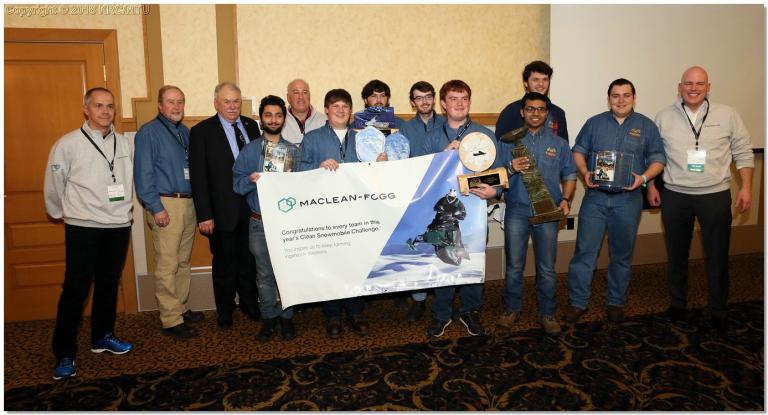
The Kettering University SAE Clean Snowmobile team finished first place overall in the SAE Clean Snowmobile Challenge Regular IC Engine Class earlier this month at Michigan Technological University.
Kettering, which competed with a total of 21 teams, also took second place overall in the Diesel Utility Snowmobile Class.
“We’re thrilled,” said team leader Alex Rath ‘17, ‘18. “We managed first place and second place competing in two classes, and we couldn’t be happier. I’ve been on the teams for the past three competition, and it was cool to see the hard work and effort we put into got us a trophy.” 
The last time the Clean Snowmobile team earned first place overall was in 2014. They earned second place overall in 2015; ninth place overall in 2016 and fifth place overall in Diesel Utility Class in 2017.
The biggest difference this year was preparation, Rath said. The team got the snowmobile running and ready to go well before leaving for the competition, which was March 5-10. Some students spent 40 hours a week on the sled in addition to their classes leading up to the competition.
“I am extremely proud of the effort of our clean snowmobile team members,” said Dr. Gregory W. Davis, Mechanical Engineering professor, Director of the Advanced Engine Research Laboratory at Kettering University and SAE Clean Snowmobile faculty advisor. "SAE collegiate design competitions give students the opportunity to put their classroom training to use to help solve real-life technical problems facing society.
“The students' approach to these issues is unique — they think outside the box. Manufacturers tend to be fairly conservative, while the students want to push the envelope — they don't know what can't be done. Often the students' efforts will challenge the manufacturers to undertake more ambitious projects and take better products to market."
The Clean Snowmobile competition focuses on conducting high-quality research on methods to reduce snowmobile emissions and sound levels without sacrificing performance. The team started with a stock snowmobile and retrofitted the powertrain to make it more fuel-efficient, have lower emissions and make less noise while keeping it reliable and fun to drive.
The competition is split between static and dynamic events, including an endurance race, acceleration event and a timed lap of the course, as well as looking at the design process, how much the snowmobile costs and how well the team can market it.
Kettering’s team had two snowmobiles at the competition — one running on gasoline and one running on diesel.
“It was a lot of time and energy, but it was worth it. I’ve always been interested in working on powertrains and engines and this competition is just that. There’s a lot more engineering involved than some other competitions,” Rath said. “We had a lot of fun. The last couple of years we spent the majority of the time getting the sleds running. This year we came in ready with both sleds running. We got to enjoy it more. That seemed to pay off.”